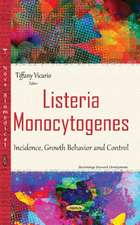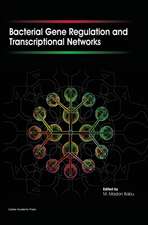E. coli in Motion: Biological and Medical Physics, Biomedical Engineering
Autor Howard C. Bergen Limba Engleză Hardback – oct 2003
| Toate formatele și edițiile | Preț | Express |
|---|---|---|
| Paperback (1) | 773.28 lei 38-45 zile | |
| Springer – 12 dec 2011 | 773.28 lei 38-45 zile | |
| Hardback (1) | 941.05 lei 6-8 săpt. | |
| Springer – oct 2003 | 941.05 lei 6-8 săpt. |
Din seria Biological and Medical Physics, Biomedical Engineering
- 5%
 Preț: 1110.32 lei
Preț: 1110.32 lei - 18%
 Preț: 1006.55 lei
Preț: 1006.55 lei - 18%
 Preț: 960.78 lei
Preț: 960.78 lei - 18%
 Preț: 704.10 lei
Preț: 704.10 lei - 18%
 Preț: 967.40 lei
Preț: 967.40 lei - 18%
 Preț: 948.92 lei
Preț: 948.92 lei - 15%
 Preț: 641.71 lei
Preț: 641.71 lei - 15%
 Preț: 644.95 lei
Preț: 644.95 lei - 15%
 Preț: 665.08 lei
Preț: 665.08 lei - 18%
 Preț: 1669.16 lei
Preț: 1669.16 lei - 18%
 Preț: 956.81 lei
Preț: 956.81 lei - 18%
 Preț: 950.21 lei
Preț: 950.21 lei - 15%
 Preț: 636.80 lei
Preț: 636.80 lei - 18%
 Preț: 947.50 lei
Preț: 947.50 lei - 15%
 Preț: 636.80 lei
Preț: 636.80 lei -
 Preț: 397.01 lei
Preț: 397.01 lei - 18%
 Preț: 1236.99 lei
Preț: 1236.99 lei - 15%
 Preț: 644.49 lei
Preț: 644.49 lei - 18%
 Preț: 946.55 lei
Preț: 946.55 lei - 15%
 Preț: 712.22 lei
Preț: 712.22 lei - 18%
 Preț: 952.89 lei
Preț: 952.89 lei - 18%
 Preț: 944.36 lei
Preț: 944.36 lei - 18%
 Preț: 1228.29 lei
Preț: 1228.29 lei - 5%
 Preț: 1422.67 lei
Preț: 1422.67 lei - 18%
 Preț: 1393.27 lei
Preț: 1393.27 lei - 15%
 Preț: 651.19 lei
Preț: 651.19 lei - 18%
 Preț: 953.65 lei
Preț: 953.65 lei - 18%
 Preț: 955.88 lei
Preț: 955.88 lei - 15%
 Preț: 644.95 lei
Preț: 644.95 lei - 5%
 Preț: 1098.48 lei
Preț: 1098.48 lei - 18%
 Preț: 959.19 lei
Preț: 959.19 lei - 15%
 Preț: 643.65 lei
Preț: 643.65 lei - 5%
 Preț: 1159.16 lei
Preț: 1159.16 lei - 5%
 Preț: 1102.67 lei
Preț: 1102.67 lei - 18%
 Preț: 952.09 lei
Preț: 952.09 lei - 18%
 Preț: 946.55 lei
Preț: 946.55 lei - 18%
 Preț: 952.09 lei
Preț: 952.09 lei - 15%
 Preț: 703.20 lei
Preț: 703.20 lei - 18%
 Preț: 953.65 lei
Preț: 953.65 lei - 5%
 Preț: 1008.41 lei
Preț: 1008.41 lei - 15%
 Preț: 644.82 lei
Preț: 644.82 lei - 18%
 Preț: 956.03 lei
Preț: 956.03 lei - 15%
 Preț: 647.40 lei
Preț: 647.40 lei
Preț: 941.05 lei
Preț vechi: 1147.63 lei
-18% Nou
Puncte Express: 1412
Preț estimativ în valută:
180.07€ • 188.00$ • 149.03£
180.07€ • 188.00$ • 149.03£
Carte tipărită la comandă
Livrare economică 04-18 aprilie
Preluare comenzi: 021 569.72.76
Specificații
ISBN-13: 9780387008882
ISBN-10: 0387008888
Pagini: 152
Ilustrații: XII, 134 p.
Dimensiuni: 155 x 235 x 15 mm
Greutate: 0.32 kg
Ediția:2004
Editura: Springer
Colecția Springer
Seria Biological and Medical Physics, Biomedical Engineering
Locul publicării:New York, NY, United States
ISBN-10: 0387008888
Pagini: 152
Ilustrații: XII, 134 p.
Dimensiuni: 155 x 235 x 15 mm
Greutate: 0.32 kg
Ediția:2004
Editura: Springer
Colecția Springer
Seria Biological and Medical Physics, Biomedical Engineering
Locul publicării:New York, NY, United States
Public țintă
ResearchCuprins
Why E. coli?.- Larger Organisms.- Cell Populations.- Individual Cells.- Flagellar Motion.- Physical Constraints.- Optimal Control.- Cellular Hardware.- Behavioral Hardware.- Genetics and Assembly.- Gain Paradox.- Rotary Motor.- Epilogue.
Recenzii
From the reviews:
Physics Today, February 2005
Review by Richard M. Berry, University of Oxford, UK
"Howard Berg’s book E. coli in Motion presents a classic example of interdisciplinary research at the interface between biology and physics, from 17th-century microscopy through major breakthroughs in the 1970s and 1980s, and up to the present. … Berg’s book is well written and accessible yet densely packed with information and insight. … As one of the founders of the modern field of bacterial chemotaxis and an eminent figure in the world of biological physics, the author writes with authority. He presents E. coli not as the faceless biochemical factory familiar to geneticists and molecular biologists, but as an individual swimming around looking for food, making decisions, and trying to get along in the world. Often he invites the reader to ‘step . . . into E. coli’s shoes,’ and he shows obvious affection for his tiny protagonist and for the process of scientific discovery. Yet, at the same time, the book gives a rigorous and essentially complete account of the field while touching on several relevant topics in molecular biology, physics, and biophysics. … E. coli in Motion is slim, and its short chapters are further divided into sections that are seldom more than a few pages long. Its style is concise and to the point. It brings simplicity and clarity in plain English to subject matter that might otherwise be complicated and difficult. The book is not short of colorful illustrations. … E. coli in Motion should appeal to a variety of readers. It is an excellently written and entertaining story of modern interdisciplinary science, full of information and without hype or wild speculation. For the specialist, it is a mine of information. But perhaps most of all, the book is a case study for anyone interested in the field of quantitative life science. I most heartily recommend it to anymathematician, physical scientist, engineer, or biologist who wants to learn more about what physics and biology can do for each other."
"The book focuses on Escherichia coli, probably the best understood of all organisms … . Berg’s book is well written and accessible yet densely packed with information and insight. … Its style is concise and to the point. It brings simplicity and clarity in plain English to subject matter that might otherwise be complicated and difficult. … should appeal to a variety of readers. It is an excellently written and entertaining story of modern interdisciplinary science … . I most heartily recommend it … ." (Richard M. Berry, Physics Today, February, 2005)
Physics Today, February 2005
Review by Richard M. Berry, University of Oxford, UK
"Howard Berg’s book E. coli in Motion presents a classic example of interdisciplinary research at the interface between biology and physics, from 17th-century microscopy through major breakthroughs in the 1970s and 1980s, and up to the present. … Berg’s book is well written and accessible yet densely packed with information and insight. … As one of the founders of the modern field of bacterial chemotaxis and an eminent figure in the world of biological physics, the author writes with authority. He presents E. coli not as the faceless biochemical factory familiar to geneticists and molecular biologists, but as an individual swimming around looking for food, making decisions, and trying to get along in the world. Often he invites the reader to ‘step . . . into E. coli’s shoes,’ and he shows obvious affection for his tiny protagonist and for the process of scientific discovery. Yet, at the same time, the book gives a rigorous and essentially complete account of the field while touching on several relevant topics in molecular biology, physics, and biophysics. … E. coli in Motion is slim, and its short chapters are further divided into sections that are seldom more than a few pages long. Its style is concise and to the point. It brings simplicity and clarity in plain English to subject matter that might otherwise be complicated and difficult. The book is not short of colorful illustrations. … E. coli in Motion should appeal to a variety of readers. It is an excellently written and entertaining story of modern interdisciplinary science, full of information and without hype or wild speculation. For the specialist, it is a mine of information. But perhaps most of all, the book is a case study for anyone interested in the field of quantitative life science. I most heartily recommend it to anymathematician, physical scientist, engineer, or biologist who wants to learn more about what physics and biology can do for each other."
"The book focuses on Escherichia coli, probably the best understood of all organisms … . Berg’s book is well written and accessible yet densely packed with information and insight. … Its style is concise and to the point. It brings simplicity and clarity in plain English to subject matter that might otherwise be complicated and difficult. … should appeal to a variety of readers. It is an excellently written and entertaining story of modern interdisciplinary science … . I most heartily recommend it … ." (Richard M. Berry, Physics Today, February, 2005)
Textul de pe ultima copertă
The bacterium Escherichia coli – E. coli for short – has long been the organism of choice for unraveling biochemical pathways, deciphering the genetic code, learning how DNA is replicated and read, and even for manufacturing proteins of commercial interest. For some thirty years, it also has been a model for studying the molecular biology of behavior. E. coli swims in a purposeful manner, propelled by long thin helical filaments, each driven at its base by a reversible rotary engine. As a microscopic organism immersed in an aqueous environment, it has mastered physical constraints utterly different from any that we know, devising sensors, comparators, and motors on the nanometer scale.
This cross-disciplinary monograph describes these feats in a manner accessible to scientists, engineers, and others not trained in microbiology who would like to learn more about living machines. It treats the history of the subject, the physiology, physics, biochemistry and genetics, largely from first principles. It is all about a small but remarkably sophisticated friend who lives in your gut.
Topics discussed include:
How does E. coli move about?
How do cells decide whether life is getting better or worse?
What is the machinery that makes this behavior possible?
How is the construction of this machinery programmed?
How does this machinery work?
What remains to be discovered?
This cross-disciplinary monograph describes these feats in a manner accessible to scientists, engineers, and others not trained in microbiology who would like to learn more about living machines. It treats the history of the subject, the physiology, physics, biochemistry and genetics, largely from first principles. It is all about a small but remarkably sophisticated friend who lives in your gut.
Topics discussed include:
How does E. coli move about?
How do cells decide whether life is getting better or worse?
What is the machinery that makes this behavior possible?
How is the construction of this machinery programmed?
How does this machinery work?
What remains to be discovered?











